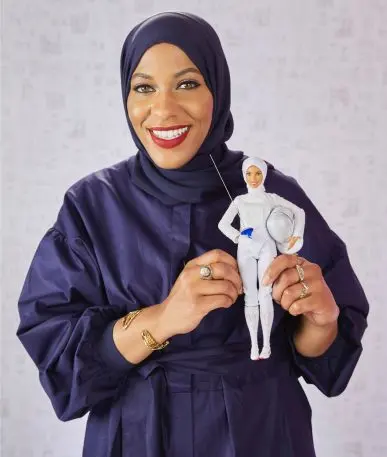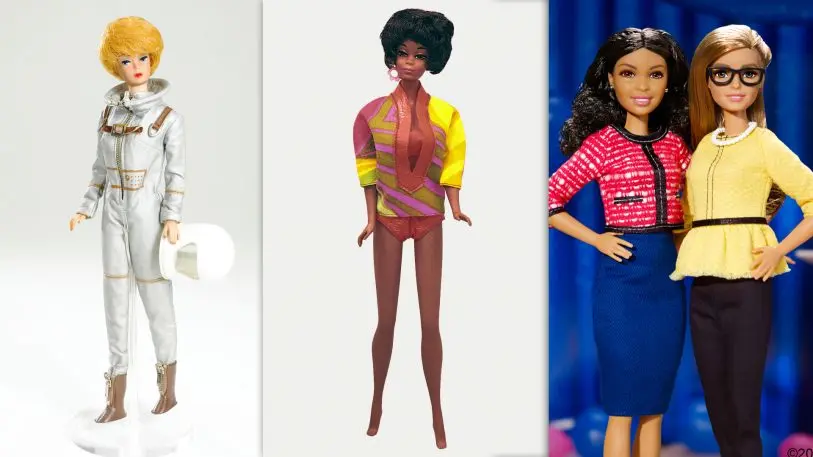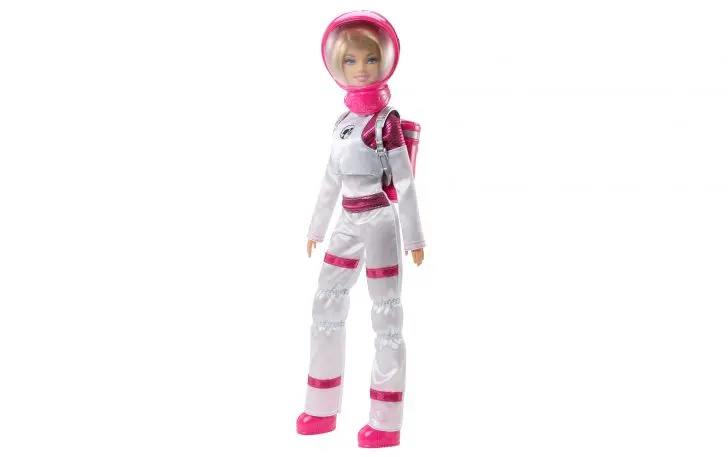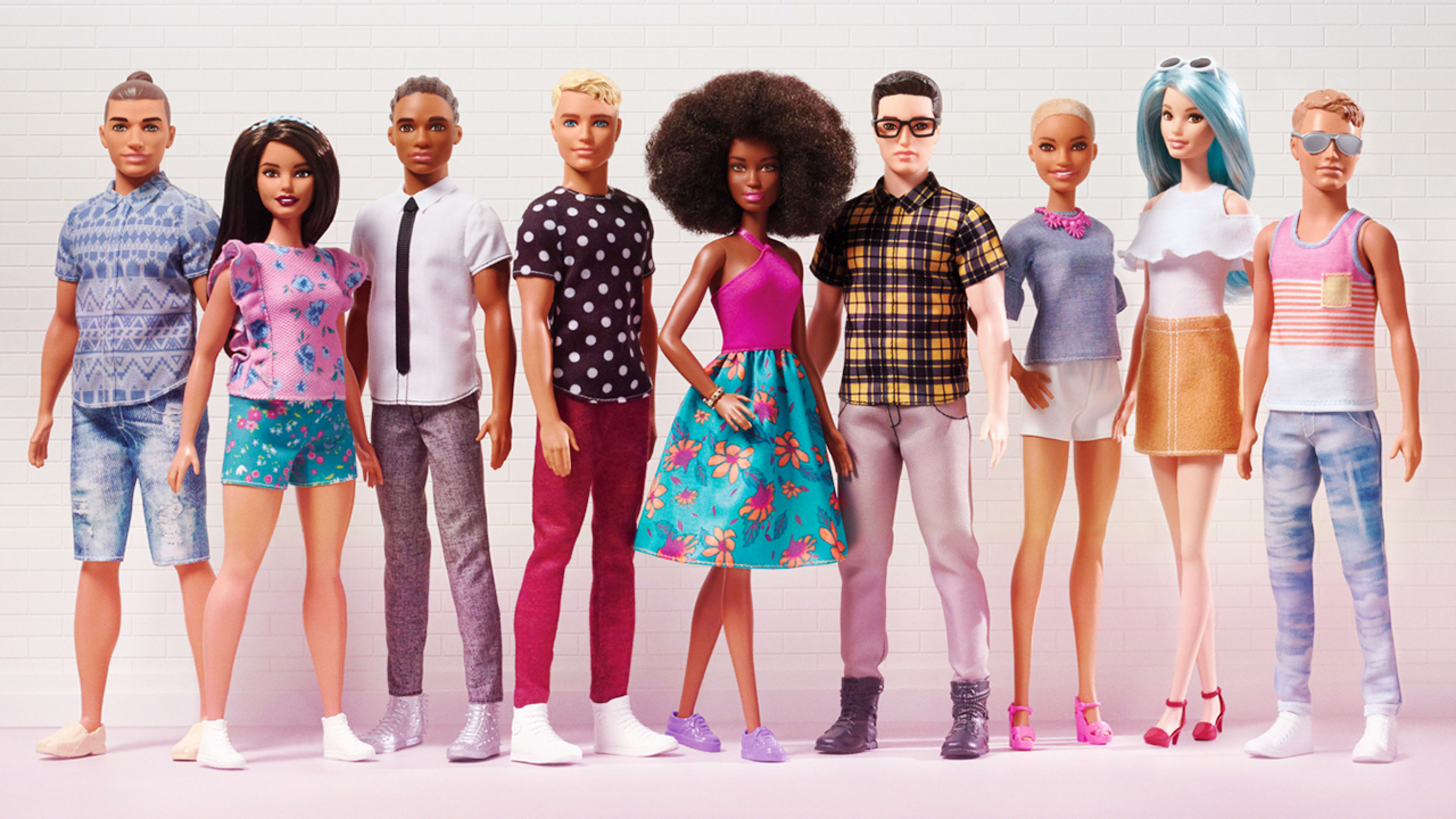Just before Thanksgiving this year, Barbie had her wokest moment yet. On the official BarbieStyle Instagram channel, she was pictured in a series of photos with another doll, Aimee, wearing T-shirts emblazoned with “Love Wins,” the slogan of the marriage equality movement. The posts were a tableaux of domesticity. In one, the pair is sitting cosily in Barbie’s walk-in closet, stroking a dog and staring into each others’ eyes. In another, they are eating avocado toast at their favorite Silver Lake café.
The status of Aimee and Barbie’s relationship wasn’t made explicit in the post, but people quickly came to their own conclusions. Along with much celebration, vitriol also exploded in Barbie’s Instagram feed, with people accusing Mattel of promoting homosexuality to young girls.
These “Love Wins” photos were part of a broader trend for Barbie. In September, the BarbieStyle Instagram account featured Barbie wearing a “People Are People” T-shirt designed by Christian Siriano as a protest against President Donald Trump’s immigration ban. Mattel also released its first hijab-wearing Barbie, modeled after the American fencer Ibtihaj Muhammad. Again, she wasn’t universally embraced: Under one Instagram post of the new doll, a commenter asked, “Does she come with a male guardian so she can go outside?”
Barbie And The Millennial Parent
Courting controversy is a bold move for Barbie, a 58-year-old brand that has been a fixture in girls’ toy boxes around the world for three generations. In the United States, Barbie’s liberal stances have been particularly striking at a time when the Trump administration has been making efforts to overturn LGBT rights in the workplace and the military, and preventing people from Muslim countries from getting visas, prompting waves of protest on both sides of the political divide.
Video: How Diversifying Barbie’s Look Dramatically Increased Sales
This effort to remake Barbie as a progressive icon appears to be a calculated business decision on Mattel’s part to win over today’s millennial parents. While Barbie is still a powerful force in the toy market, generating $971 million in sales in 2016, younger parents have been less keen on buying the doll for their daughters than those in generations past. Mattel has seen sales of Barbie spiral downward since 2009. Between 2012 and 2014 alone, sales dropped by 20%. Part of this decline is due to the fact that kids are increasingly choosing to play with touch screens and electronic toys, rather than with old-fashioned dolls. (One of the best-selling toys this holiday season is a small robotic monkey called Fingerling that blows kisses and blinks.) But analysts have also attributed the decline of Barbie to the fact that Mattel hasn’t been able to shake the stigma that the brand is a bad influence on girls because she promotes sexism.
“Millennial parents are a very different demographic than generations before,” says Christia Spears Brown, a psychology professor and author who studies gender stereotypes in children. (She has also written for Fast Company). “They’re trying to make more socially conscious decisions in a world where there are an infinite number of possibilities when it comes to shopping. They want to spend their money in ways that align with their values, and we’re seeing a trend of parents being very sensitive to the gender stereotypes found in toys.”
According to Pew Social Trends, millennials are more ethnically diverse, progressive, and tolerant than older generations. They are most likely to identify as liberal Democrats, which is perhaps why Mattel has been so comfortable having Barbie take anti-Trump stances. Now aged between 20 and 36, they are starting families and want to introduce their progressive values to their children.
Video: The Fantastic, Plastic Brand Evolution of Barbie
Yet, there is plenty of widely disseminated evidence that Barbie teaches girls to be skinny, beautiful, and attractive to men. Research shows that girls aged 5 to 8 who are exposed to images of Barbie report lower body esteem and a greater desire to be skinny than girls who are not. And there is some evidence that playing with Barbies can limit a girl’s ability to imagine what she can be as an adult. Another study found that girls between 4 and 7 who played with Barbie saw fewer career options for themselves than for boys.
Mattel has been acutely aware that it needs to change the perception of the Barbie brand. At the start of 2016, the company made a big push to make Barbie more inclusive by creating a wider array of body types. For decades, all Barbies had been the same physical shape, which consisted of enormous breasts, a tiny waist, and very long thin legs. Many have pointed out that if these features were transmuted onto a real woman, she would have half a liver, very little intestine, and would tip over from being too top-heavy. Last year, Mattel launched three new body types–curvy, petite, and tall–that came in seven skin tones, 22 eye colors, and 24 hairstyles.
Related: How Diversifying Barbie’s Look Dramatically Increased Sales
But it wasn’t enough. While Mattel saw a brief uptick in Barbie sales, driving 11% growth in the first quarter of 2016, sales tumbled every single quarter after that. In a YouGov survey, only 35% of consumers had a positive impression of the Barbie brand before these more inclusive dolls came out, and this figure only went up to 41% after the new products launched. It’s possible that the brand simply didn’t push these dolls hard enough: The curvy dolls, for instance, aren’t prominently featured on the Barbie Instagram feeds, and it was close to impossible to find them on the aisles of my local Toys”R”Us and Target stores. At the time of publishing, the featured dolls on the Barbie website included one based on the model Gigi Hadid, and a set of skinny dolls in glamorous red holiday gowns.

A History Of Controversy
While the plus-sized, LGBT-friendly, or hijab-wearing Barbies seem like a new twist on the brand’s image, Barbie has, in fact, spurred quite a lot of controversy during her 58-year history. Michelle Chidoni, Mattel’s VP of communications, points out that the brand has always looked for ways to capture the imagination of each generations of girls and their parents by playing into important cultural–and sometimes contentious–trends. “As the brand has continued to evolve over the last 60 years, one of the ways that we continue to be relevant is by being a reflection of the time,” Chidoni says.
Mattel first brought Barbie to market in 1959. She was priced at $3, which is the equivalent of $25 today, and was described as a teenage fashion model, a career that provided a good excuse to sell parents lots of interchangeable outfits that cost between $1 and $5 (roughly $8 and $42 in today’s currency). From very start, the doll was met with scandal because consumers in the ’50s thought she was too sexy for young girls to play with. That reaction was not particularly outlandish: Ruth Handler, the doll’s creator, had modeled Barbie on a German sex doll called Lili that was targeted at men, not children.
But despite this initial pushback, Barbie managed to thrive. At a time when most girls only had paper dolls, a three-dimensional doll at an affordable price point was a winning concept. Mattel sold 351,000 Barbies in its first year, marking a new sales record for the toy industry. And that success continued for the next few decades. Nearly a billion Barbies have been sold around the world, and there was a time when 92% of American girls owned a Barbie. The fact that the dolls have stuck around for nearly six decades is a feat, since most toys have a shelf life of four years, according to Chidoni.
Related: The Fantastic, Plastic Brand Evolution of Barbie
The very first Barbies reinforced many of the stereotypes of women in the early ’60s: The doll was cast as a bride, a hostess, and a guest at a red-carpet affair. But it wasn’t long before Mattel started pushing the envelope of what Barbie could do. The company created an astronaut Barbie in 1965, four years before NASA’s moon mission and nearly two decades before the first American woman went into space. In 1969, it created Christie, a black doll designed to be Barbie’s friend, right after race riots were breaking out in the U.S. in the wake of Martin Luther King, Jr.’s assassination. (South Asian, East Asian, and Latina dolls would come in the ’80s.) It has created a Presidential Candidate Barbie almost every election year since 1992, a full 24 years before Hillary Clinton ran for president.

Not Woke Enough
While Mattel has tried to expand Barbie’s range of career choices, the vast majority of dolls sold on the market are still the $9.99 fashion dolls, Chidoni says. As I walked through my local Toys”R”Us, I noticed a couple of play sets that present Barbie as a vet and a spaghetti chef, but there are dozens more that are part of the “fashionista” line. “The fashion doll piece is absolutely the centerpiece of the line,” Chidoni says. “This doll is the key to the system of play, because you need this doll to enable the storytelling and imagination. Changing what she is wearing changes her role and where she is going.”
Related: Using ToyTalk Technology, New Hello Barbie Will Have Real Conversations With Kids
Brown thinks that kids–and their parents–still see these fashion dolls as the face of the brand because they are so dominant in Barbie imagery as well as on the toy aisle. These days, when dolls like Lottie and GoldieBlox teach girls the fundamentals of engineering, Barbie’s obsession with clothes seems out of sync with the culture. “Barbie really hasn’t updated in any meaningful way,” Brown says. “They do these special issue dolls every once in a while, but the brand itself hasn’t fundamentally changed.”

In other words, Barbie is caught in a bind: Mattel needs to sell parents on more progressive versions of the doll, but it might take years of marketing for this new version of Barbie to become familiar and exciting enough for kids to want them. “You have to do more than offer one of these curvy or career dolls in the corner,” Brown says. “It’s a chicken and egg problem: If you offer enough of these dolls, over time, once kids get used to them, eventually they will start asking for them. Then the dolls will become profitable and it would be worth stocking them.”
The Barbie brand reflects the cultural shift that is happening in the U.S. Barbie was invented before the feminist revolution, when it was still acceptable to talk about how a young woman’s job was to snag a husband and keep him happy by staying attractive. The doll was designed to be pretty and fashionable, and in some ways, these values are baked into the brand’s DNA. In the grand scheme of Mattel’s history, the progressive, career-oriented Barbies are aberrations, rather than the norm.
All of this seems terribly retrograde as we head into 2018. At a time when sexual harassment scandals are capable of toppling powerful movie producers and politicians, and 5 million women around the world marched in January 2017 to advocate for human rights, many of today’s parents aren’t willing to tolerate a doll that carries even a whiff of sexism. “We’re in the middle of a culture war between the progressives interested in social change and others nostalgic for a time past,” Brown says. “Toy companies put themselves in one of those factions, and when you’re still making a princess Barbie, you’ve picked one of those sides. It’ll be interesting to see if Barbie is still around in 10 years.”
Recognize your brand’s excellence by applying to this year’s Brands That Matter Awards before the early-rate deadline, May 3.
